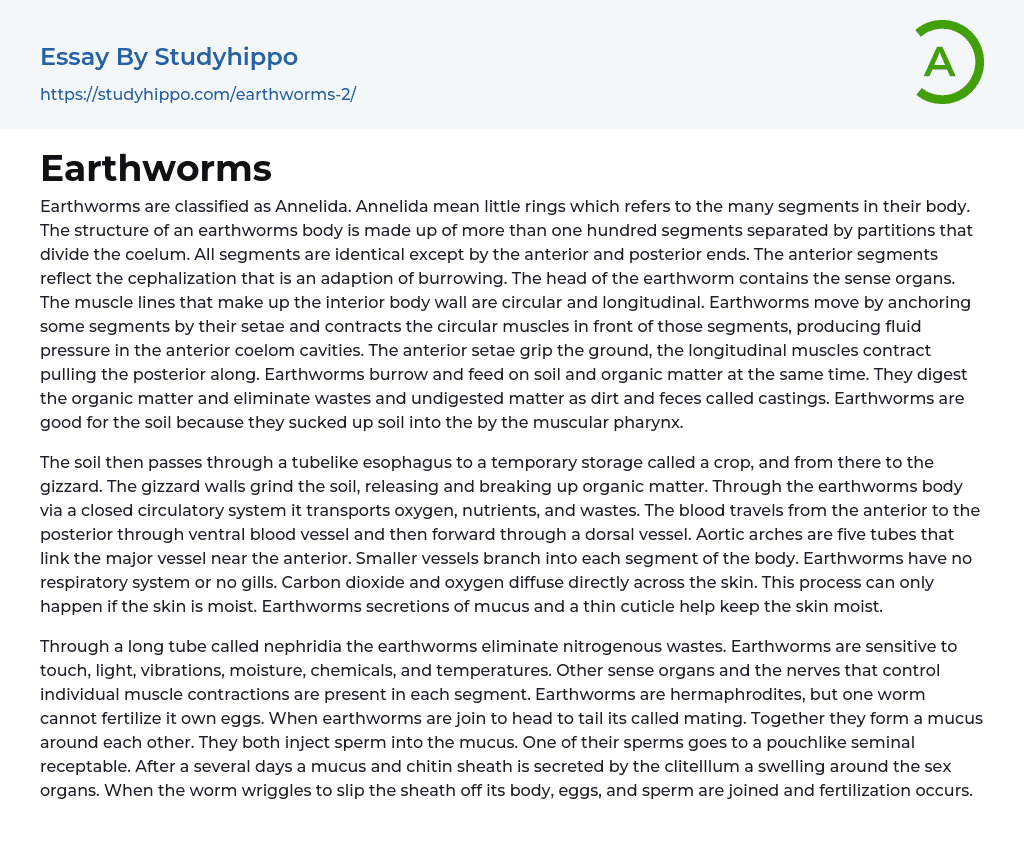Earthworms, which are classified as Annelida, have a body structure consisting of numerous segments that are separated by partitions. These segments, except for the anterior and posterior ends, are identical. The anterior segments, which contain the sense organs, exhibit cephalization, an adaptation for burrowing. The interior body wall is composed of circular and longitudinal muscles. To move, earthworms anchor certain segments with their setae and contract the circular muscles in front of those segments, resulting in fluid pressure in the anterior coelom cavities. The anterior setae grip the ground while the longitudinal muscles contract, pulling the posterior along. Earthworms engage in both burrowing and feeding on soil and organic matter. They digest the organic matter and excrete waste and undigested materials as castings – dirt and feces. Due to thei
...r muscular pharynx, earthworms are capable of sucking up soil, which is beneficial for the soil's health.
The soil is first transported through a tubelike esophagus to a temporary storage area known as a crop, and then to the gizzard. In the gizzard, the soil is ground up by the walls, breaking up organic matter. Oxygen, nutrients, and wastes are transported through the earthworm's body via a closed circulatory system. Blood flows from the anterior to the posterior through a ventral blood vessel, and then forward through a dorsal vessel. There are five aortic arches that connect the major vessel near the anterior. Smaller vessels branch into each segment of the body. Earthworms do not have a respiratory system or gills. Carbon dioxide and oxygen diffuse directly across their skin. However, for this process to occur, the skin must be moist. The earthworm'
secretion of mucus and a thin cuticle help maintain moisture in the skin.
Earthworms eliminate nitrogenous wastes through nephridia, a long tube. They possess sensitivity towards touch, light, vibrations, moisture, chemicals, and temperatures. Each segment contains sense organs and nerves that control muscle contractions. Earthworms are hermaphrodites, unable to self-fertilize. Mating occurs when two earthworms join head to tail and form a mucus around themselves. Sperm is injected into the mucus, with one sperm going to a seminal receptacle. After several days, the clitellum, a swelling around the sex organs, secretes a mucus and chitin sheath. When the worm wriggles to remove the sheath from its body, fertilization happens as the eggs and sperm combine.
- Rabbit essays
- Distribution essays
- Large Animals essays
- Mouse essays
- Poultry essays
- Animal Abuse essays
- Cats Vs Dogs essays
- Cattle essays
- Territory essays
- Microbiology essays
- Bacteria essays
- Cell essays
- Enzyme essays
- Photosynthesis essays
- Plant essays
- Natural Selection essays
- Protein essays
- Viruses essays
- Cell Membrane essays
- Human essays
- Stem Cell essays
- Breeding essays
- Biotechnology essays
- Cystic Fibrosis essays
- Tree essays
- Seed essays
- Coronavirus essays
- Zika Virus essays
- Agriculture essays
- Albert einstein essays
- Animals essays
- Archaeology essays
- Bear essays
- Biology essays
- Birds essays
- Butterfly essays
- Cat essays
- Charles Darwin essays
- Chemistry essays
- Dinosaur essays
- Discovery essays
- Dolphin essays
- Elephant essays
- Eli Whitney essays
- Environmental Science essays
- Evolution essays
- Fish essays
- Genetics essays
- Horse essays
- Human Evolution essays




